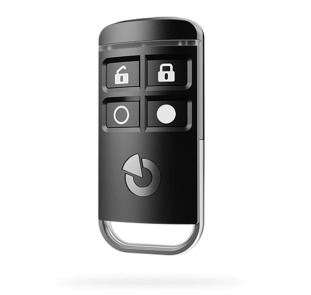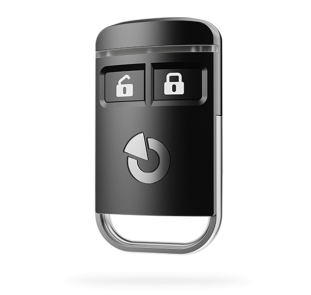CA-345 Car alarm with local signaling and immobilizer
Overview of car alarm functions
- Integrated CAN bus converter. Vehicle status information (unlocking and locking the vehicle with the original R.C. (remote control), turning on the ignition key, opening the door, bonnet, boot) can be obtained through the CAN bus connection without any impact on its communication.
- An integrated shock detector has adjustable sensitivity using a trimmer inside the unit. Its triggering can result in an alert (1s siren sound), trigger an alarm or both. If the alarm function is activated, a filter eliminating incidental shocks (e.g. a heavy vehicle passing by ...) is applied. An alarm is only triggered if the first shock is followed by another one within 15 seconds. If both the alert and alarm function are activated, the alarm responds to the first shock with a short sound and after the second shock (within 15 s), an alarm is triggered.
- A voltage drop sensor detects whether, with the alarm being armed, a device in the car has not been switched on (protection e.g. against mechanical unlocking of the central locking), which results in an abrupt voltage drop. The sensor is blocked for 20 minutes after arming (enables a rundown of the engine cooling fan). It can be deactivated using the software (parameter 8) if independent devices are used in the car (heating, fridge).
- The alarm is equipped with several alarm inputs the number of which depends on the alarm wiring method, see below.
- Up to 12 wireless detectors of the JABLOTRON 100+ serie can be enrolled to the car alarm. They can monitor movement in the car, the breaking of a window as well as the space of the garage where the vehicle is parked.
- A programmable output can switch the power supply for supplementary detectors (microwave, tilt detector) that are active when the alarm is armed, or it provides a signal for the control of the MCB-03 and MCO-04 (AUX) modules.
- The blocking relay circuit can be used to disconnect e.g. the car starter, fuel pump or ignition circuit. With the AUTOIMO function on, the car cannot be started if the ignition key has been off for more than 5 minutes. The function is unblocked using a remote control button.
- In the case of an alarm, the output of the siren is activated for 30 s. If the alarm is resolved in a correct way, the sounding of the siren will stop immediately.
- If the car is handed over to a repair shop, the AUTOIMO function and the acoustic indication can be easily temporarily switched off.
- Optical indication of arming, disarming and an alarm. The car alarm can control the direction indicators of the vehicle in three selectable modes.
- Opening the boot. In the disarmed state, the car boot can be opened remotely if its mechanical system makes its possible (the BLK output function must be set to boot control).
- PANIC is a function of sounding the siren using the remote control both in the armed and disarmed state (by simultaneously pressing both the buttons). It can be used to quickly find the car in a car park. This function is selectable with parameter 17 (PANIC).
- For emergency disarming, the alarm is equipped with a Valet button. It is also used to set optional parameters.
- Information about the operational statuses is indicated with an LED.
- Car alarm settings and parameters can be adjusted easily with the use of the CA-340PRG wireless device connected to a PC.
Technical specifications
| Power supply | 12/24 V (9 – 32) V DC |
|---|---|
| Idle current consumption | max. 20 mA |
| Operating frequency | 1 RF channel, GFSK, 868.1 MHz |
| RC receiver | 868.1 MHz, GFSK, ERP <25 mW |
| Operating temperature range | -40 °C to 85 °C |
| Alarm duration | 30 sec |
| Current carrying capacity of the blocking relay | 8 A continuous, 12 A intermittent |
| Current carrying capacity of the BLK output | 200 mA |
| Current carrying capacity of the PGM output | 25 mA |
| Current carrying capacity of the ULK/LCK outputs | 200 mA |
| Ingress protection class (according EN 60529) | IP40 |
| Dimensions | 118 x 80 x 35 mm |
| Complies with the regulation | ECE No. 116 |
| Electrical safety | EN 62368-1 |
| EMC | ECE No. 116, ETSI EN 301 489-1, -3, -7 |
| Radio parameters | ETSI EN 300 220-1, -2 |
| Operation conditions, general authorization | ECC/DEC/(04)06, ERC/DEC/(97)02, ECC/DEC/(06)01; ERC/REC 70-03 |
Related products
JA-185P Wireless ceiling PIR detector
The JA-185P is a small-size wireless PIR sensor suitable for protecting small rooms or car interiors. It is designed for wall or ceiling installations.
JA-185B Wireless ceiling glass-break detector
A small-size glass-break sensor that detects window breaking. It is designed for building interior installations. It uses the analysis of air pressure variations combined with the characteristic sound of glass-breaking.
JA-154J MS II Bi-directional four-button keyfob
It enables the remote control of the security system, plus various electric appliances, or triggering an emergency alarm. Confirmation of the execution of a command through optical and acoustic feedback.
JA-152J MS II Bi-directional two-button keyfob
It enables the remote control of the security system, plus various electric appliances, or triggering an emergency alarm. Confirmation of the execution of a command through optical and acoustic feedback.
MCB-03 Innovated CAN bus converter
This product replaces the older MCB-02 module. It supports reading data from CAN buses, newly also FD CAN and LIN bus. The module converts digital information to analogue form, in order to connect to the inputs of the CA-2103, CA-345 and other car alarms. It switches information on vehicle locked/unlocked status, ignition status, door open and close, hood open and close, etc.
MCO-04 Car alarms output module
The product is an extension module for CA-2103 and CA-345 series car alarms for controlling appliances in the vehicle - independent heating, power supply for additional detectors, control of optical signalling and other functions.










